A low-sodium diet is vital for your heart health and can help prevent issues like high blood pressure and heart disease. You should aim for a daily intake of no more than 2,300 mg, ideally 1,500 mg. Common sources of excess sodium are processed foods, canned goods, and fast food. To lower your intake, use herbs and spices for flavor, choose fresh ingredients, and read nutrition labels. Preparing meals at home lets you manage sodium levels. Incorporating a variety of foods guarantees a balanced diet. There's a lot more to discover about tasty low-sodium options and effective strategies.
Key Takeaways
- Aim for a daily sodium intake of 2,300 mg or ideally 1,500 mg for better heart health.
- Avoid processed foods, canned soups, and fast food, which often contain hidden sodium.
- Use herbs, spices, vinegar, and citrus to flavor meals instead of salt.
- Incorporate fresh fruits, vegetables, whole grains, and lean proteins into your diet for balanced nutrition.
- Practice portion control to manage overall dietary intake and support weight management.
Understanding Sodium Intake
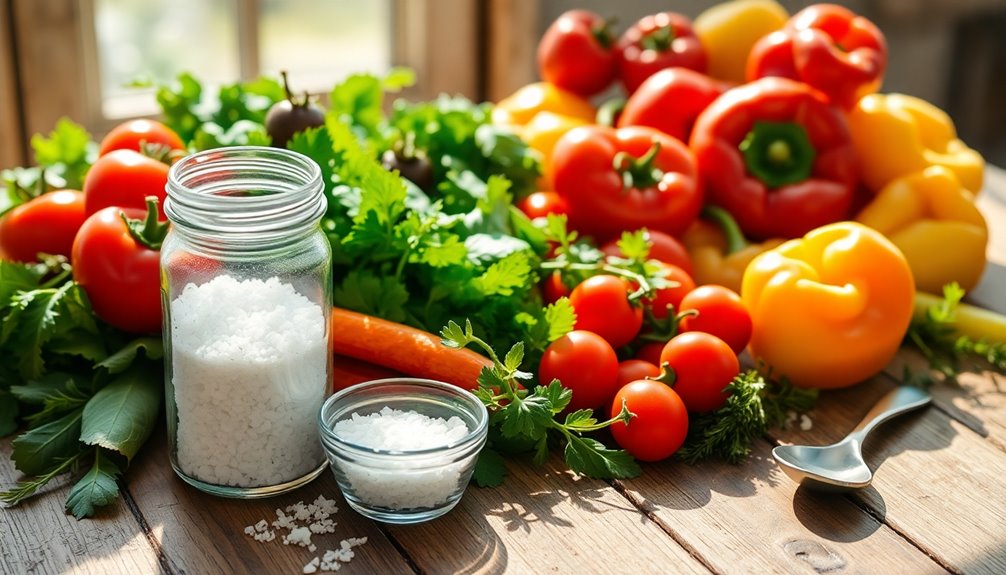
Sodium, a mineral necessary for various bodily functions, can easily become a dietary concern when consumed in excess. Most health organizations recommend limiting sodium intake to about 2,300 milligrams per day, with an ideal target of 1,500 milligrams for adults, especially those with certain health conditions. It's essential to be aware of these sodium recommendations, as high sodium levels can lead to health issues like high blood pressure.
One challenge in managing sodium intake is the presence of hidden sodium in many processed foods. You might be surprised to find that items like bread, sauces, and even yogurt often contain more sodium than you'd expect. Reading labels can help you identify these hidden sources, but it's not just about checking numbers; it's about understanding what you're consuming. In fact, traditional bread can contribute significantly to your sodium intake, while also posing risks associated with high-carb bread consumption.
Cooking at home allows you to control the ingredients and sodium levels in your meals. Opt for fresh ingredients whenever possible, and try seasoning your dishes with herbs and spices instead of salt. This not only reduces sodium but can enhance flavor and nutrition.
When you make conscious choices about sodium intake, you're not just following dietary guidelines; you're actively participating in your health journey. It's empowering to recognize how small changes can lead to significant benefits. By being mindful of sodium recommendations and the hidden sodium in your diet, you're taking important steps towards a healthier lifestyle that encourages belonging within your community.
Health Benefits of Low-Sodium Diet
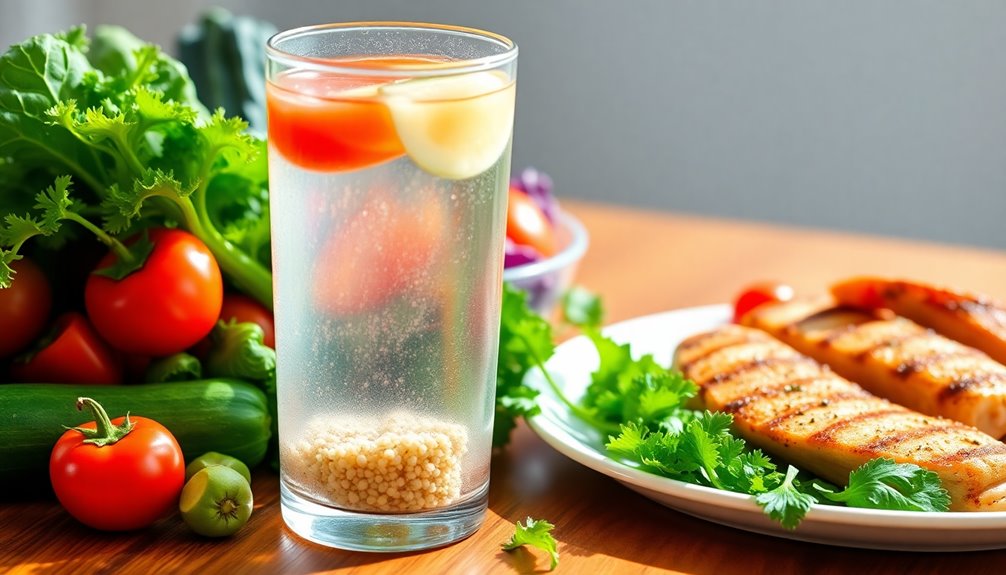
Reducing sodium intake can lead to significant health improvements. One of the most notable benefits is improved heart health. High sodium consumption is linked to elevated blood pressure, which can strain your heart and blood vessels. By cutting back on sodium, you may lower your blood pressure levels, reducing your risk of heart disease and stroke. Studies show that even a modest reduction in sodium can make a big difference in cardiovascular health.
Additionally, you'll likely experience decreased bloating when you adopt a low-sodium diet. Sodium retains water in your body, leading to puffiness and discomfort. When you reduce your intake, your body will flush out excess fluid, helping you feel lighter and more comfortable. This can also enhance your overall sense of well-being.
A low-sodium diet isn't just about avoiding certain foods; it's about embracing a lifestyle that promotes better health. You'll find that many fresh fruits, vegetables, and whole grains are naturally low in sodium, making them excellent choices. Incorporating these foods into your meals not only supports heart health but also provides essential nutrients that boost your energy and liveliness. Furthermore, adopting a custom keto diet can complement your low-sodium efforts by focusing on nutrient-dense foods.
Common Sources of Sodium
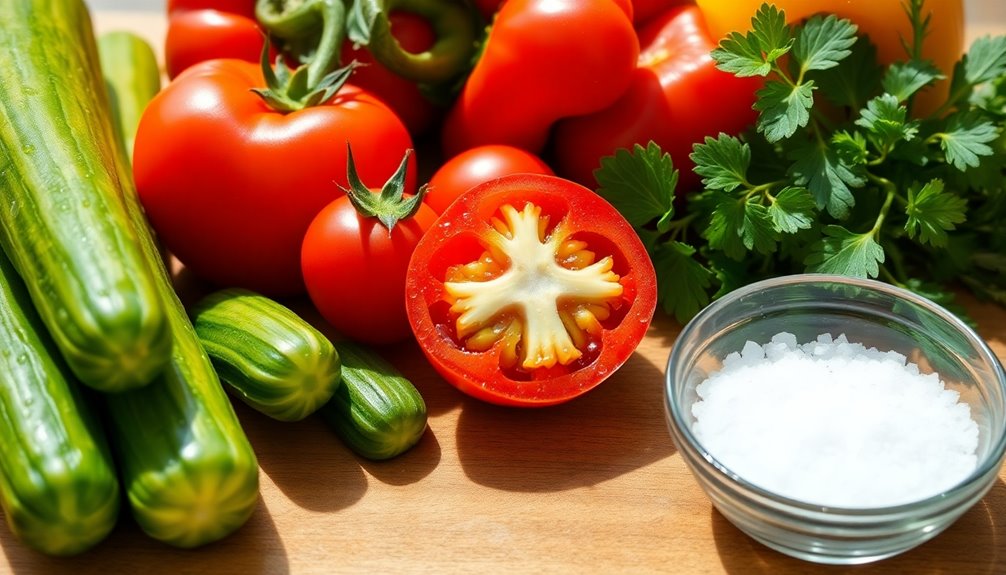
Many everyday foods can surprisingly pack a hefty sodium punch, making it pivotal to be aware of your dietary choices. Processed and packaged foods are some of the biggest culprits, often containing hidden sodium that can quickly elevate your intake beyond recommended levels.
For instance, canned soups, sauces, and frozen meals might seem convenient, but they're loaded with salt to enhance flavor and preserve freshness. Even seemingly healthy options like salad dressings and bread can contribute significant sodium to your diet.
Fast food is another major source of sodium. Burgers, fries, and pizza are notorious for their high salt content, which can lead to exceeding your daily limit with just one meal. Watch out for deli meats and cheeses as well; these items often contain added salt for flavor and preservation.
If you're looking to reduce your sodium intake, consider sodium alternatives. Herbs, spices, and citrus juices can add flavor without the added salt. Experimenting with fresh ingredients can also help you discover new tastes while keeping your meals healthy.
Reading nutrition labels is essential in identifying hidden sodium. Look for options labeled "low-sodium" or "no added salt" to make more informed choices. Additionally, studies indicate that processed foods are a primary source of excessive sodium intake, emphasizing the importance of mindful eating. By being mindful of the sodium content in your food, you can take control of your diet and enjoy a healthier lifestyle that fosters belonging within your community.
Tips for Reducing Sodium
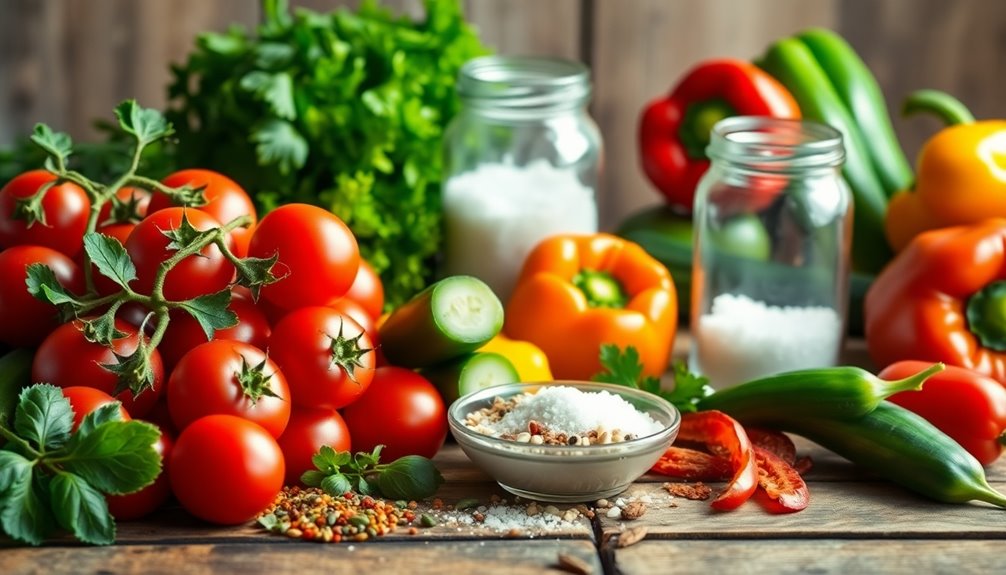
Cutting back on sodium doesn't have to feel overwhelming. With a few simple strategies, you can easily reduce your intake while still enjoying delicious meals. Here are some practical tips to help you on your journey:
- Substituting seasonings: Use herbs, spices, and citrus to add flavor without the sodium. Basil, oregano, garlic, and lemon juice can enhance your dishes.
- Reading labels: Always check the nutrition facts on packaged foods. Look for products labeled "low sodium" or "no salt added" to make better choices.
- Opting for fresh: Fresh fruits, vegetables, and meats generally contain less sodium than processed options. Incorporating more whole foods is a great way to naturally lower your intake.
- Cooking at home: Preparing meals from scratch gives you full control over what goes into your dishes, allowing you to limit sodium.
- Rinsing canned goods: If you use canned beans or vegetables, rinse them under water before cooking. This can significantly decrease their sodium content.
Maintaining a healthy balance of gut bacteria is crucial for overall well-being, as imbalances can exacerbate health conditions like Chronic Kidney Disease.
Flavorful Low-Sodium Recipes
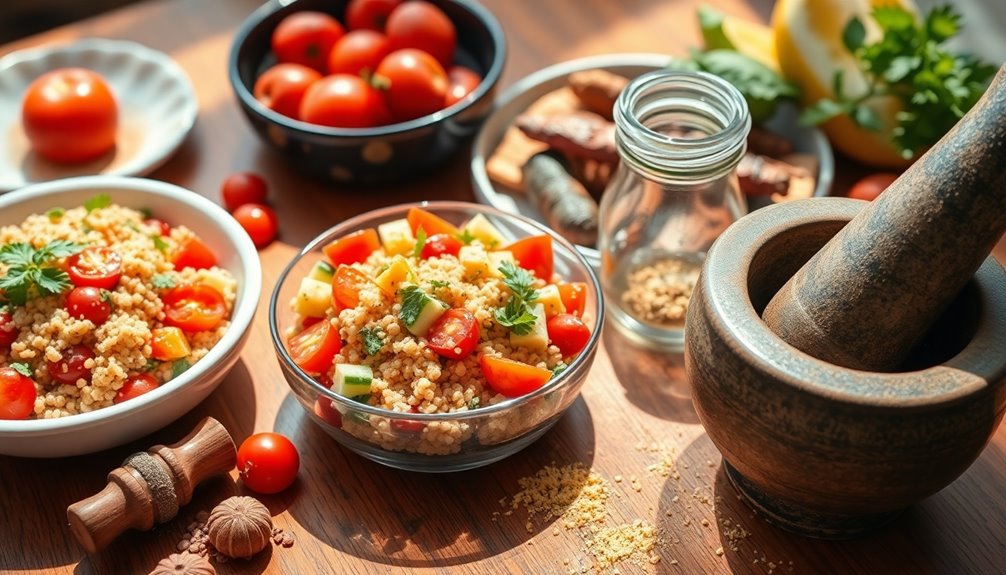
While you might think that a low-sodium diet limits your culinary options, there are plenty of flavorful recipes that prove otherwise. With a little creativity and some meal planning, you can enjoy delicious dishes that satisfy your taste buds without relying on salt.
Start by exploring creative substitutions. For instance, use herbs and spices like garlic, ginger, or cumin to add depth to your meals. A simple garlic and herb chicken can become a family favorite by marinating the chicken in lemon juice, olive oil, and a mix of your favorite herbs, enhancing flavor without additional sodium.
You can also try using acids like vinegar or citrus juice to brighten up your dishes.
When it comes to vegetables, roasting them can reveal their natural sweetness. Toss your favorite veggies with a bit of olive oil and spices before roasting for a delicious side dish. Another idea is to experiment with grains and legumes. Quinoa, brown rice, and lentils can be seasoned with low-sodium broth or spices for hearty, filling meals.
For snacks, consider making your own popcorn seasoned with nutritional yeast or a sprinkle of your favorite spices. It's an easy and fun way to enjoy a low-sodium treat.
Incorporating these flavorful, low-sodium recipes into your meal planning can help you maintain a delicious and satisfying diet. You'll find that with a bit of thoughtfulness, you can create meals that celebrate flavor without compromising your health. Additionally, adopting a plant-based diet can further enhance the nutritional value of your meals while keeping sodium levels low.
Maintaining a Balanced Diet
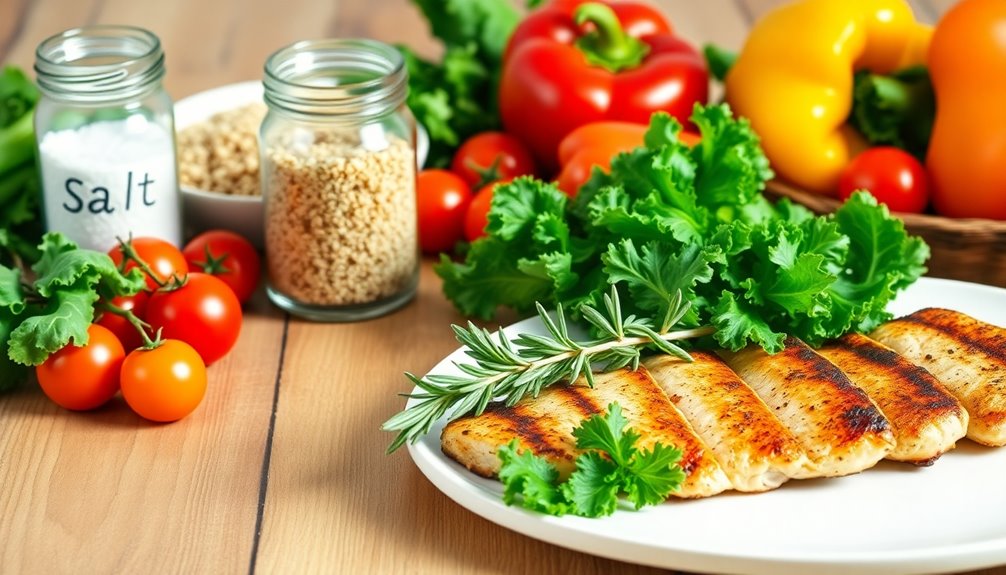
To preserve a balanced diet, you need to focus on integrating a variety of foods from all the food groups. This approach not only supports your overall health but also helps you manage your sodium intake effectively. Nutrition education plays a crucial role in guiding your food choices, ensuring you understand the importance of each group in your diet.
Here are some key components to prioritize:
- Fruits and Vegetables: Aim for a diverse variety to maximize vitamins and minerals.
- Whole Grains: Choose whole-grain options instead of refined grains for better fiber and nutrients.
- Lean Proteins: Incorporate sources like fish, poultry, beans, and nuts, which are lower in sodium.
- Dairy: Opt for low-fat or fat-free dairy to provide calcium without excess sodium.
- Healthy Fats: Include sources such as olive oil and avocados to support heart health.
Portion control is equally important. Learning to gauge appropriate serving sizes can help you enjoy a range of foods without overindulging. This balance not only aids in weight management but also allows you to relish the flavors of your meals. Additionally, including whole-food sources of protein in your diet can enhance your nutritional intake and support overall health.
Frequently Asked Questions
Can I Still Eat Out on a Low-Sodium Diet?
Yes, you can definitely eat out while maintaining a low-sodium diet! Many restaurants offer low sodium swaps, like grilled chicken instead of fried, or fresh veggies instead of salty sides. Just ask your server for options.
You can also bring along some low sodium snacks to keep your cravings in check. Enjoying dining out is still possible; it just takes a little planning and awareness of your choices. You've got this!
Are There Any Supplements for Low-Sodium Diets?
Imagine trying to paint a vibrant landscape with only muted colors. When you're looking for supplements to enhance your meals, low sodium seasoning alternatives can transform bland dishes into flavorful ones.
You might also consider hydration tips, like adding citrus to water, boosting taste without added salt. While some supplements exist, focusing on natural herbs and spices can provide the flavor you crave while supporting your health goals.
You're not alone in this journey!
How Does Sodium Affect Blood Pressure?
Sodium plays an essential role in regulating blood pressure. When you consume excess sodium, your body retains more water, leading to increased blood volume. This puts extra pressure on your blood vessels, raising your blood pressure.
Your kidneys help manage sodium levels, but if they're overwhelmed, it can lead to long-term hypertension. Monitoring your sodium intake can support kidney function and help maintain a healthy blood pressure, fostering a sense of well-being in your life.
What Are the Symptoms of High Sodium Intake?
If you've been consuming too much sodium, you might notice some symptoms. Salt cravings can increase as your body seeks to balance itself.
You may also experience water retention, causing bloating or puffiness, especially in your hands and feet.
High sodium intake can lead to headaches or elevated blood pressure, which may leave you feeling uneasy.
Staying aware of these signs can help you maintain your well-being and foster a healthier lifestyle.
Can Children Follow a Low-Sodium Diet?
Yes, children can follow a low-sodium diet, and it can be beneficial for their health.
You can choose healthy snacks like fresh fruits, vegetables, and unsalted nuts to keep their sodium intake low.
When packing school lunches, opt for whole grains, lean proteins, and low-sodium spreads.
Conclusion
Incorporating a low-sodium diet isn't just about cutting back; it's about enhancing your overall health and well-being. By being mindful of your sodium intake, you're not just avoiding potential health risks; you're savoring a world of flavors that can elevate your meals. Remember, your heart deserves the best, and small changes can lead to big benefits. So, why not take the plunge? Your taste buds—and your body—will thank you for it!



